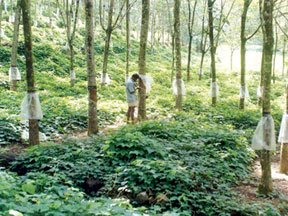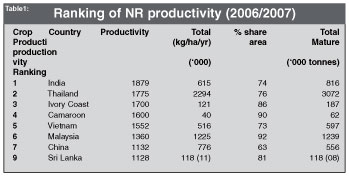Sri Lanka's natural rubber productivity still lagging behind
Dr. N. Yogaratnam, Consultant/National Institute of
Plantation Management
 The centenary of Research on Rubber in Sri Lanka (not the Rubber
Research Institute of Sri Lanka) is expected to be celebrated next year.
Yet, it is disappointing that the rubber industry is still lagging
behind in terms of crop productivity by global standards. The centenary of Research on Rubber in Sri Lanka (not the Rubber
Research Institute of Sri Lanka) is expected to be celebrated next year.
Yet, it is disappointing that the rubber industry is still lagging
behind in terms of crop productivity by global standards.
Research has made many significant contributions. Crop productivity
has been increased by about 10 fold from about 450 kg/ha/yr to the
present level of about 4500 kg/ha/yr although the plantation management
has not been able to keep pace with this trend.
International Rubber Study Group's (IRSG) latest estimates (Box 1)
indicate that India recorded the highest productivity of 1879 kg/ha/yr
in recent years, with 89% share of area under rubber in smallholdings,
followed by Thailand with 17750 kg/ha, Ivory coast 1700, Cameroon with
1600, Vietnam 1552 kg/ha and so on.
Sri Lanka, although has been showing an increasing trend, yet it is
still ranked ninth with a crop productivity of about 1128 kg/ha/yr. Some
plantation companies have been able to achieve much higher levels of
productivity in the region of 1800 to 2000 kg/ha/yr in some fields,
demonstrating that potential exits for higher yield and has to be
exploited by the plantation management for the industry to continue to
enjoy the benefit of the current market boom.
Total Out put
 Table 1, shows the recent trend in total output along with total area
in rubber and the percentage share of mature rubber in production for
comparison. Table 1, shows the recent trend in total output along with total area
in rubber and the percentage share of mature rubber in production for
comparison.
As can be seen, while Thailand is the current number one in terms of
total output Indonesia has a larger area under rubber with low level of
productivity, yet there is a possibility of overtaking Thailand in the
future in terms of total out-put. One can easily guess which countries
might be in the top five in the near future.
In Sri Lanka, although rubber planted areas are expected to increase
by about 40,000 hectares, unless the level of crop productivity is
increased, we will not be recognised as a significant contributor to
global Natural Rubber (NR) out-put.
Sri Lanka's total output of about 118,000 tonnes in 2007 places it at
the eighth position in the global scenario with crop productivity in the
ninth position and the total area under rubber in the eleventh position
with 118, 000 hectares, this is likely to go up by 40,000 to 158,000
hectares.
Global NR/ SR (Synthetic rubber)
The total world NR production was expected to reach about 9.8 million
tonnes in 2007, but its growth fell sharply from almost 10% to around 3%
at the end of 2007.
On the other hand, growth in SR production has been steady and has
even improved in recent months to 3.7% bringing it to 12.98 million
tonnes.
Global NR supply is supported by continued increase in production in
Indonesia while there have been a decline in Thailand, Malaysia and
India.
Impact of NR / SR prices
The sharp rise in NR prices that was seen again from the middle of
August continued through to end of the year. This was driven possibly
due to short term supply concerns and rampant oil prices and has had its
negative effects as well.
For example, India has been increasing particularly sharply in recent
years, the percentage of SR consumption in the tyre manufacturing
sector.
Rising NR prices, the basic raw material for making automobile tyres,
has been squeezing the margins of tyre manufacturers, forcing them to
increasingly look at SR as an alternative raw material.
The average ratio of NR : SR decreased from the year 2005 level of 79
: 21 to 74 : 26 in 2006.This had been a worrying factor to Indian rubber
growers.
Oil prices have been increasing, reaching a record high of almost U$
100 a barrel in November. This sharp rise, however, it has been
reported, has not been matched by SR and its feedstocks prices,
demonstrating that demand rather than cost push is the important factor
influencing the prices of the SR recently.
As SR prices have been relatively stable compared to NR, the gap
between the two prices is again widening to almost 40%.
Forecasts
IRSG has forecasted that the NR/ SR consumption growth would be
upward in the region of 4.9% in 2007, but downward to 2.2% in 2008,
before the growth is expected to pick up again in 2009 to show an annual
growth rate of 3.8 % during the 3 year period.
Weather related problems have always been crucial factors in rubber
production, and this has resulted in a downward trend of the growth in
global NR output to only 1.3% in 2007.
It is forecast that this trend would pick up in 2008 and 2009
bringing the annual growth rate of about 3.1%, although climatologists
are concerned over the changing weather patterns observed in the recent
years.
Global SR output is projected to increase by about 3.4% a year.
NR supply/demand balance

The forecasted global NR supply / demand balance indicates that the
trends of slower growth in supply and rising demand are expected to push
excess supply down sharply.
Sri Lankan scenario
The international economic environment appears to be deteriorating in
the recent months and is not expected to recover until mid-2009. Oil
fell more than U$ 1.00 to a one month low below U$ 89.00 per barrel in
mid- January with concerns that a recession in the US could drag down
other economies, as well.
Weather related problems due to unpredictable changes in weather
pattern are also matter for worry. The fluctuations in rubber market
that have now become a regular phenomena, would therefore continue more
violently in the near future.
Sri Lanka still being a small player in global rubber business should
continue to up crop productivity and output. The rapid improvement of
crop productivity depends upon the application of long term and short /
medium term approaches in rubber crop husbandry.
Long term approach
* Staff and worker development programmes, should be in place. RRI
and NIPM have the professional competence to provide such services, but
the industry's priorities appear to be different.
* Development of degraded soils in order to restore productivity,
increase productivity and to prevent deterioration of productivity
* Selection of new plantings, replanting land by adopting stringent
criteria and ensuring that the fields selected have the potential for
higher productivity.
* Improving the genetic character of holding using the right
combination of clones in the field. Clones RRISL 200 series as well as
the emerging RRISL 2000 which have a higher potential should be
considered.
* Using quality planting materials raised in their own nurseries by
adopting stringent procedures
Short/medium aspects
* Skilful manipulating of planting practices and balanced input of
fertilisers in the immature phase
* Adoption of stringent tapping standards and stimulation ( Ethephone)
of virgin as well as renewed panels ( BO - 1, BO - 2, B1 - 1, B1-2,
B2-1)
Productivity improvement is a macro level feature of importance in
rubber plantation scenario. Despite the lower extent under rubber,
target should be set to rise annually by about 05% in the medium term,
1240 kg/ha by 2010, 1364 kg/ha by 2012 with a projected national crop
productivity target of about 1800 kg/ha by year 2015.
The plantations companies with well established infrastructure and
access to unlimited capital should take the lead with their maximum
yields in the region of 2000 kg/ha, serving as a benchmark. Research's
efforts and achievements in crop productivity, processing and value
addition technologies will be nullified if due emphasis is also not
given by the industry to value addition.
In the ultimate analysis, the issue centers around the extent to
which the rubber industry and indeed, the country benefits from
corporate sector management of plantations.
Professionalism in management is known to be associated with
impossible looking goals, miraculous solutions unheard of triumphs etc.
We are in the era of professionalism in business management. Why not the
plantation management? |

